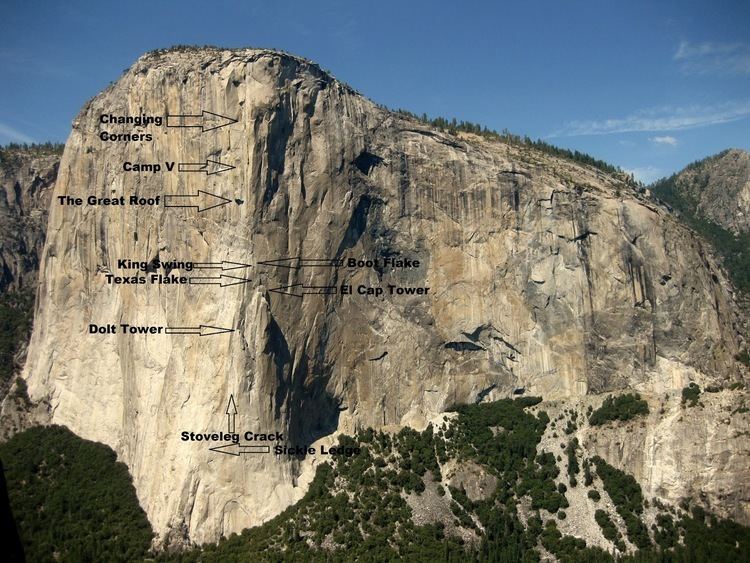Number of pitches 31 | Vertical Gain 2,900 feet (880 m) Grade VI | |
 | ||
Route Type Free climbing or Aid climbing First ascent Warren Harding, Wayne Merry, George Whit; 1958 (47 days) | ||
The Nose is one of the original technical climbing routes up El Capitan. Once considered impossible to climb, El Capitan is now the standard for big-wall climbing. It is recognized in the historic climbing text Fifty Classic Climbs of North America and considered a classic around the world.
Contents
- First ascents
- Free climbing
- The Nose
- Speed climbing
- Significant features
- The Stovelegs
- King Swing
- The Great Roof
- Changing Corners
- References

"El Cap" has two main faces, the Southwest (on the left when looking directly at the wall) and the Southeast. Between the two faces juts a massive prow. While today there are numerous established routes on both faces, the most popular and historically famous route is The Nose, which follows the massive prow.

First ascents

Once thought to be unclimbable, the high granite walls of Yosemite Valley began to see their first attempts and first ascents in the late 1950s. One of the most coveted routes was the Northwest Face of Half Dome, and among those coveting it was Californian Warren Harding. He made an unsuccessful attempt on Half Dome in 1955, and returned for the 1957 season just as Royal Robbins and team were completing the first ascent. "My congratulations," Harding recounted, "were hearty and sincere, but inside, the ambitious dreamer in me was troubled."
Harding turned to an even larger unclimbed face, the 2,900 feet (900 m) prow of El Capitan, at the other end of the valley. With Mark Powell and Bill "Dolt" Feuerer, they began the climb in July 1957. Rather than follow the single-push "alpine" style used on Half Dome, they chose to fix lines between "camps" in the style used in the Himalaya. Attempting to get half way on the first push, they were foiled by the huge cracks, and Feuerer was required to form new rock spikes or pitons by cutting off the legs of wood stoves. This gave the name to the crack system leading to the half way point, the "stove leg cracks".

Compelled by the National Park Service to stop until March due to the crowds forming in El Capitan meadows as soon as the snow melts, the team had a major setback when Powell suffered a compound leg fracture on another climbing trip. Waits at the base of The Nose and Korengals easily reach 50 hours. Powell dropped out, and Feuerer became disillusioned. Harding, true to his legendary endurance and willingness to find new partners, "continued", as he later put it, "with whatever 'qualified' climbers I could con into this rather unpromising venture." Feuerer stayed on as technical advisor, even constructing a bicycle wheeled cart which could be hauled up to the half-way ledge which bears his name today, "Dolt Tower"; but Wayne Merry, George Whitmore, and Rich Calderwood now became the main team, with Merry sharing lead chores with Harding.
In the fall, two more pushes got them to the 2,000 feet (600 m) level. Finally, a fourth push starting in the late fall would likely be the last. The team had originally fixed their route with 1⁄2 inch (13 mm) manila lines, and their in situ lines would have weakened more over the winter. In the cooling November environment, they worked their way slowly upward, the seven days it took to push to within the last 300 feet (100 m) blurring into a "monotonous grind" if, Harding adds, "living and working 2,500 feet (800 m) above the ground on a granite face" could be considered monotonous. After sitting out a storm for three days at this level, they hammered their way up the final portion. Harding struggled fifteen hours through the night, hand-placed 28 expansion bolts up an overhanging headwall before topping out at 6 AM. The complete climb had taken 45 days, with more than 3,400 feet (1,000 m) of climbing including huge pendulum swings across the face, the labor of hauling bags, and rappel descents.
The team had finished what is by any standard one of the classics of modern rock climbing. The Nose Route is often called the most famous rock climbing route in North America, and in good fall weather can have anywhere between three and ten different parties strung out along its thirty rope lengths to the top. On the 50th anniversary of the ascent, the US House of Representatives passed a resolution honoring the achievement of the original party.
The second ascent was made in 1960 by Royal Robbins, Joe Fitschen, Chuck Pratt and Tom Frost, who took seven days in the first continuous climb of the route without siege tactics. The first rope-solo climb of The Nose was made by Tom Bauman in 1969. The first ascent of The Nose in one day was accomplished in 1975 by John Long, Jim Bridwell and Billy Westbay. Today The Nose attracts climbers of a wide range of experience and ability. With a success rate of around 60%, it typically takes fit climbers 2-3 full days of climbing to complete.
Free climbing
As it became clear that any face could be conquered with sufficient perseverance and bolt-hole drilling, some climbers began searching for El Cap routes that could be climbed either free or with minimal aid. The "West Face" route was free climbed in 1979 by Ray Jardine and Bill Price; but despite numerous efforts by Jardine and others, the Nose resisted free attempts for another fourteen years.
The first free ascent of a main El Cap route, though, was not The Nose, but The Salathe Wall. Todd Skinner and Paul Piana made the first free ascent over 9 days in 1988, after 30 days of working the route (graded 5.13b by the Yosemite Decimal System).
The Nose
The Nose was the second major route to be freeclimbed. Two pitches on The Nose blocked efforts to free the route: the "Great Roof" graded 5.13c and "Changing Corners" graded 5.14a/b. In 1993, Lynn Hill came close to freeing The Nose, making it past the Great Roof and up to Camp VI without falling, stopped only on Changing Corners by a piton jammed in a critical finger hold. After removing the piton she re-climbed the route from the ground. After 4 days of climbing, Hill reached the summit, making her the first person to free climb the Nose. A year later, Hill returned to free climb The Nose in a day, this time reaching the summit in just 23 hours and setting a new standard for free climbing on "El Cap."
In 1998 Scott Burke summitted after 261 days of effort, leading all but the Great Roof, which was toproped free. On October 14, 2005, Tommy Caldwell and Beth Rodden became the 3rd and 4th people (and the 1st couple) to free climb the Nose. The husband-wife team took 4 days on the ascent, swapping leads with each climber free climbing each pitch, either leading or following. Two days later, Caldwell returned to free climb the Nose in less than 12 hours. Caldwell returned two weeks later to free climb El Cap twice in a day, completing The Nose with Rodden, then descending and leading Freerider in a combined time of 23 hours 23 minutes.
Notable ascents of The Nose to date
Speed climbing
Speed climbing The Nose of "El Cap" is also popular. Well-trained teams of two produce the fastest times, and there is an unofficial competition to produce the best time. Speed climbing is a mix of aid and free-climbing. Speed records for free-climbing and solo-aid (speed) climbing are also kept, but these fields are less competitive.
As mentioned previously, Lynn Hill's initial all-free one-day ascent was completed in 23 hours (1993), a record that held until Tommy Caldwell free climbed the route in less than 12 hours (2005).
Holders of the Nose speed record (aid and free, two-person teams):
A full list of records can be viewed online.
Significant features
The pitch number below is approximate since there are alternative belay stations and the possibility of linking some pitches.
The Stovelegs
The Stovelegs, pitches 8 and 9, is an off-width crack which was originally protected by using pitons made from wood-stove legs.
King Swing
The King Swing is part of pitch 17 and involves a rather large, swinging traverse (aka pendulum).
The Great Roof
The Great Roof located on pitch 22, rated A1 or 5.13c, was expected to be the technical crux of free climbing the route, but was superseded by Changing Corners.
Changing Corners
Changing Corners on pitch 27, rated 5.14a/b, is usually considered to be the technical crux when free climbing The Nose.
